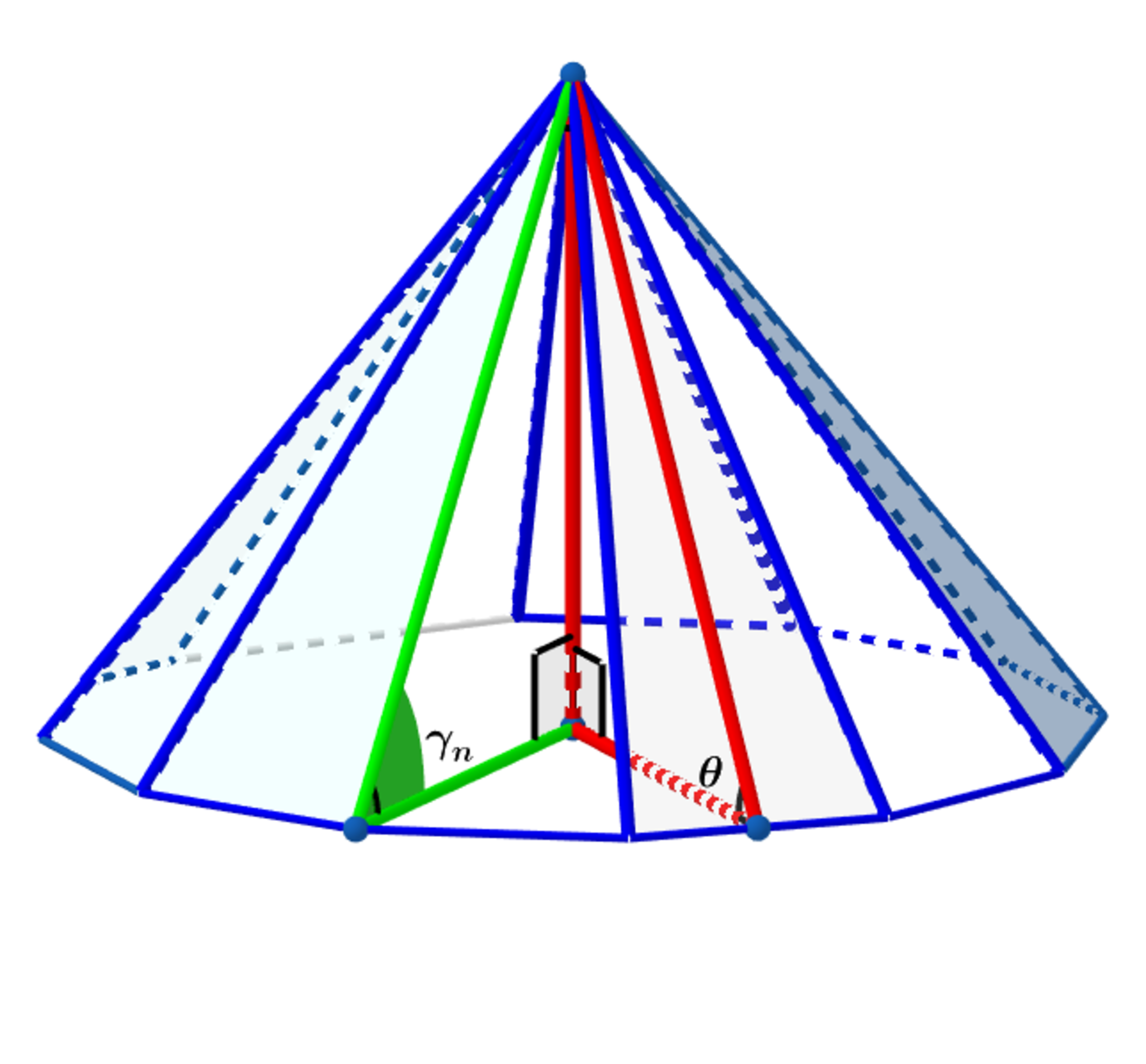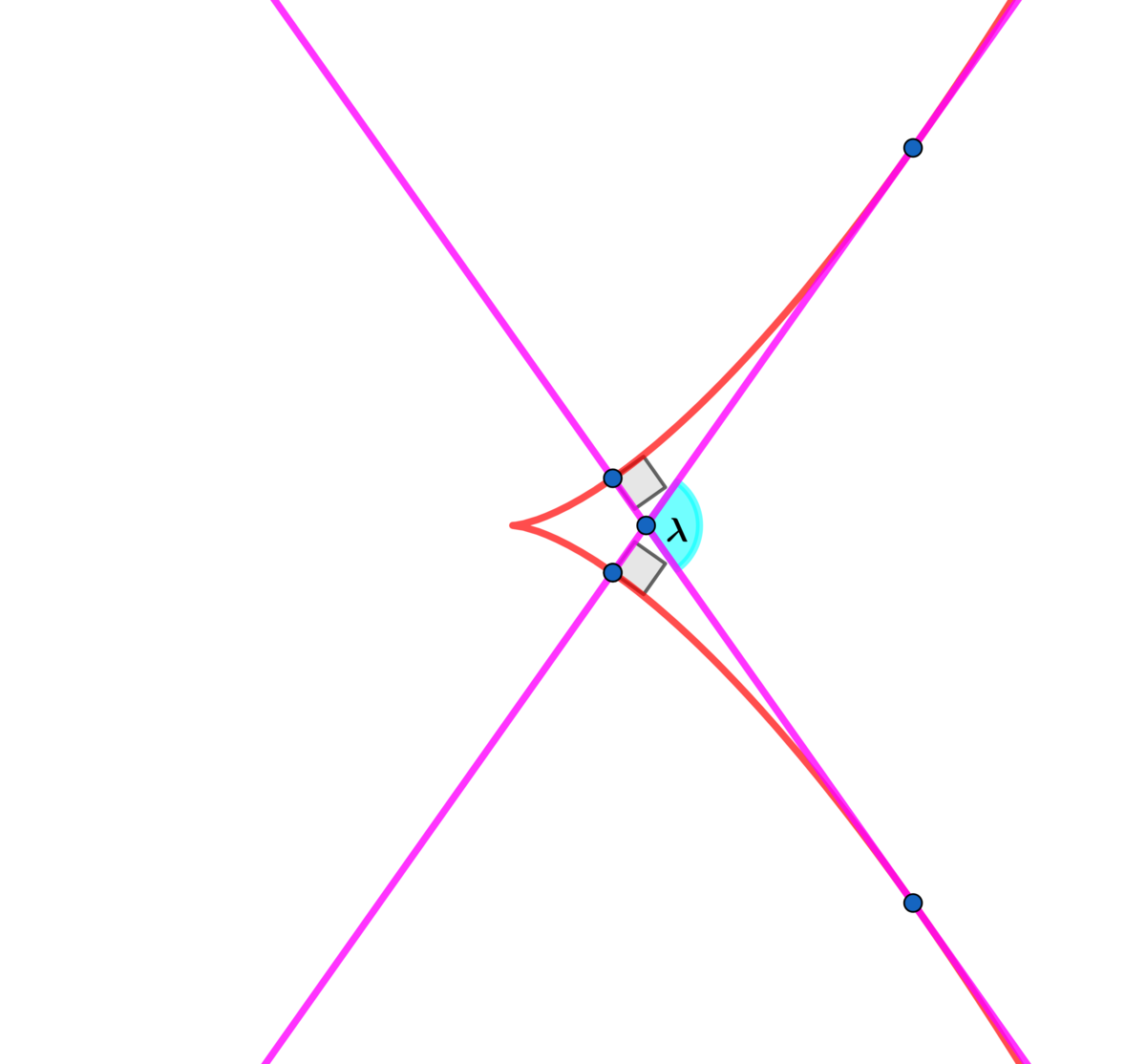Compare 2.

Let be a positive integer and be a pyramid whose base is a regular -gon.
Let be the angle of inclination (in degrees) made between the slant height and the base which minimizes the lateral surface area of the pyramid when the volume is held constant.
Find the angle and show the angle is independent of .
Let be the angle of inclination (in degrees) made between an edge and the base which minimizes the lateral surface area of the pyramid above when the volume is held constant
Find .

Let .
There are two lines which are both tangent and normal to the above curve.
Find the angle (in degrees) made between the two lines above.
Find .
The answer is 2.
This section requires Javascript.
You are seeing this because something didn't load right. We suggest you, (a) try
refreshing the page, (b) enabling javascript if it is disabled on your browser and,
finally, (c)
loading the
non-javascript version of this page
. We're sorry about the hassle.
For area of n − g o n :
Let B C = x be a side of the n − g o n , A C = A B = r , A D = h ∗ , and ∠ B A D = n 1 8 0 .
2 x = r sin ( n 1 8 0 ) ⟹ r = 2 sin ( n 1 8 0 ) x ⟹ h ∗ = 2 x cot ( n 1 8 0 ) ⟹ A △ A B C = 4 1 cot ( n 1 8 0 ) x 2 ⟹
A n − g o n = 4 n cot ( n 1 8 0 ) x 2 ⟹ the Volume of the pyramid V p = 1 2 n cot ( n 1 8 0 ) x 2 H
The lateral surface area P ∗ = 2 n x ∗ s , where s is the slant height.
V p = K (constant) ⟹ H = n ∗ c o t ( n 1 8 0 ) x 2 1 2 K ⟹ P ∗ ( x ) = 2 m ( n ) x 1 ( j ( n ) ∗ m ( n ) ) 2 x 6 + ( 2 4 K ) 2 , where m ( n ) = cot ( n 1 8 0 ) and j ( n ) = n ∗ m ( n )
⟹ d x d P ∗ = 2 m ( n ) ( j ( n ) ∗ m ( n ) ) 2 x 6 + ( 2 4 K ) 2 ∗ x 2 2 ( j ( n ) ∗ m ( n ) ) 2 x 6 − ( 2 4 K ) 2 = 0 ⟹ x = ( 2 ( j ( n ) ∗ m ( n ) ) 2 ( 2 4 K ) 2 ) 6 1
⟹ H = ( j ( n ) ) ∗ ( 2 ( j ( n ) ∗ m ( n ) ) 2 ( 2 4 K ) 2 ) 3 1 1 2 K
⟹ tan ( θ ) = h ∗ H = 2 ⟹ θ = arctan ( 2 ) ≈ 5 4 . 7 3 5 6 1 and tan ( γ n ) = r H = 2 cos ( n 1 8 0 ) ⟹ tan ( γ ) = lim n → ∞ tan ( γ n ) = 2 ∗ lim n → ∞ cos ( π / n ) = 2 = tan ( θ ) .
Let x ( t ) = a t 2 + b , y ( t ) = c t 3 + d ⟹ d x d y ∣ ( t = t 1 ) = 2 a 3 c t 1 ⟹ the tangent line to the curve at ( x ( t 1 ) , y ( t 1 ) ) is: y − ( c t 1 3 + d ) = 2 a 3 c t 1 ( x − ( a t 1 2 + b ) )
Let the line be normal to the curve at ( x ( t 2 ) , y ( t 2 ) ) ⟹ c ( t 2 − t 1 ) ( t 2 2 + t 1 t 2 + t 1 2 ) = 2 3 c t 1 ( t 2 − t 1 ) ( t 2 + t 1 ) ⟹ 2 c ( t 2 − t 1 ) ( 2 t 2 2 − t 1 t 2 − t 1 2 ) = 0 t 1 = t 2 ⟹ t 2 = − 2 t 1
Since the tangent is also normal to the curve at ( x ( t 2 ) , y ( t 2 ) ) ⟹ 4 a 2 9 c 2 t 1 t 2 = − 1 ⟹ 8 a 2 9 c 2 t 1 2 = 1 ⟹ t 1 = ± 3 c 2 2 a ⟹ the two slopes are ± 2 .
tan ( θ ) = 2 ⟹ θ = arctan ( 2 ) ≈ 5 4 . 7 3 5 6 1 ⟹ λ = 2 θ ≈ 1 0 9 . 4 7 1 2 2 .
⟹ θ 2 λ γ = θ 2 2 θ 2 = 2 .
.